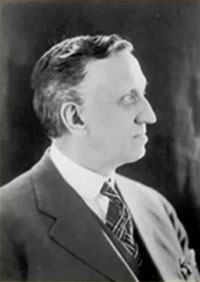Saint John and Quebec Railway (Valley Line)Reporting mark: CNR
The Saint John and Quebec Railway, also known as the "Valley Line," was a small short line with a brief but colourful history. It was ostensibly built to fulfill a longstanding wish to connect the communities along the Saint John River. There was also some hope that improved transportation facilities would encourage the growth of new industries. The construction of the National Transcontinental Railway (NTR) provided the necessary impetus to get the project started.

Promoter and US politician
Source: Wikipedia
In reality, the good citizens of Saint John, miffed at being bypassed by the NTR, saw an opportunity in building the railway northward to Grand Falls where it would connect with the NTR. The railway could then serve the twofold purpose of promoting growth and providing a connection to the NTR. It was finally incorporated in 1910 by Arthur Robinson Gould, president of the Aroostook Valley Railroad in the state of Maine, and a future US politician
At first the project was bogged down in partisan political bickering between the federal and provincial governments. A change in government at the federal level in 1911, and the arrival of new premier James Kidd Flemming, paved the way for speedy approval. Construction finally began in 1912.
Gould's contract called for a line that ran from Saint John to Grand Falls. He received provincial guarantees of $5 million in first mortgage bonds and $1 million in bridge bonds from the federal government. Upon completion, the federal government was contracted to operate the railway, returning 40 per cent of the gross to the province. A second plan to build a branch through Gould's home state of Maine to connect with the Canadian Northern Railway in Quebec was nixed.
The route did not make a lot of sense. It was considerably longer than the more well-established Canadian Pacific Railway (CPR) and ran almost parallel with the CPR between Fredericton and Woodstock.
At first construction progressed well. Then the costs turned out to be higher than projected. The railway was forced to seek further provincial aid, which was doled out to the tune of $35,000 per mile. Construction was halted in 1914 due to the war. Portions of the railway were actually disassembled and the materials sent to Europe for military use.
The railway's financial problems, while very serious, paled in comparison to the political headaches it was about to bestow on its biggest boosters. In December 1914, Premier Flemming was forced to resign after an investigation revealed that, among other things, he induced the railway contractors to make large donations to the Conservative party.
By 1915 the railway had defaulted on its commitments and the provincial government was forced to step in and take over. Gould in turn filed a claim for $500,000 in compensation. During the arbitration proceedings, Gould admitted to paying $100,000 to Flemming for his "assistance." Whether the money went to Flemming or to his party is unknown. Efforts to recover the money were unsuccessful largely because Flemming was rarely available due to his frequent bouts with illness.
In addition to his claim for compensation, Gould filed a further claim for reinstatement to the position of director on the basis that he had been unlawfully removed. Both claims were refused, the latter having worked its way up to the New Brunswick Supreme Court in 1921. During his quest for a US senate seat in 1926, Gould stated the $100,000 bribe was paid by his associates and was standard practice for American companies dealing with the New Brunswick government. He added that Flemming had asked for an additional $50,000 which was refused. Whichever version was true there is little doubt that political standards on both sides of the border were deplorably low. Gould was exonerated by his own countrymen and sworn in as a senator.
Beset with construction delays during World War 1, the line was finally completed in 1919 and the railway went into operation. It didn't take long for the government to figure out that they had a red herring on their hands. Determined to cut their losses, the government axed the section from Centreville to Grand Falls. Nonetheless, the railway continued to bleed cash and by the 1920s, the government wanted out. Abandonment was seriously considered but in the end the government was able to persuade Canadian National to purchase the line for $6 million. The sale was completed in 1929.
The cancellation of passenger service in 1952 marked the beginning of the end for the Saint John and Quebec Railway. In 1967 the section between Fredericton and Woodstock was closed due to flooding. From then on the railway was gradually abandoned in stages until 1995 when it ceased to exist altogether.
